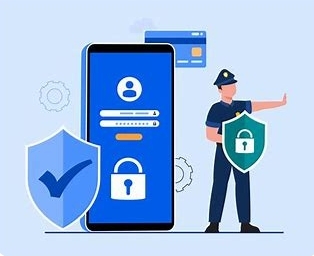Security goals in information security: It is imperative to understand the security goals of information security. This is because it will help you to have a clearer objective of what security goals in information security are.
security goals in information security are generally referred to as the practices which are intended to secure personal information from unauthorized access and modification all through the storing and broadcasting from one point to another.
Information security is designed to protect digital, print, personal, sensitive, and private information from unauthorized persons.
When this is properly utilized will prevent information from being misused, modified, interrupted, destroyed, and affirmation.
Now security goals in information security are those objectives or primary focuses that one needs to bear in mind while setting up security protection for sensitive information or personal data.
What are the 3 security goals in information security?

For you to properly protect your information, you must ensure that your security meets this security goal in information security.
Here are the three security goals in information security:-
1. Confidentiality:-
Confidentiality is one of the three essential security goals in information security. Confidentiality is associated with secrecy and the use of encryption technology. You have to make sure that the data is only accessible only to authorized users and parties. When any information has been kept confidential it means that it has not been tempered with unauthorized users. Confidential data are protected from people who are not authorized to access them. Making your information confidential means that such information is organized in terms of who is authorized to access the data and also the sensitivity of the data. A breach of confidentiality can take place through hacking or social engineering.
2. Integrity:-
Data/information integrity is among the security goals in information security, it means that the data being submitted or transmitted is not tempered with at any stage. This refers to the certainty that the data has not been subjected to unauthorized access and modification, either intentional or unintentional. Data can be compromised easily at two points “During the uploading/transmission of data and the storage of the documents in a database or collection.
3. Availability:-
Data availability is also the mean part of security goals in information security, it refers to the availability of information/data to only authorized users at any time of need. For a system to demonstrate availability, the computing system must be working properly, including the communication channels. Critical systems such as power generated action, and safety systems sometimes usually have high requirements when it comes to availability. This system must be properly protected from cyber threats, and also safeguard against hardware failures and other events that might affect the system availability.
YOU CAN ALSO READ : THE USE OF BLAZOR VS JAVASCRIPT IN WEB DEVELOPMENT
What is the primary goal of information security?
The primary security goal in information security is to protect the confidentiality, integrity, and availability of an organization’s information assets. This includes protecting important data and information from unauthorized access, use, alteration, or destruction. Information security also aims to ensure that the information is reliable, accurate, and trustworthy for authorized users.
The reasons why security goals in information security are important are many. Firstly, it helps an organization maintain customer trust and confidence, which is essential for any business to thrive in a competitive market. Secondly, information security helps in achieving regulatory compliance, as many industries have specific rules and regulations that require them to implement security measures to protect sensitive data. Additionally, information security helps prevent intellectual property theft and cybercrime, which can lead to financial loss and reputational damage.
In conclusion, the primary goal of information security is to protect an organization’s information assets from unauthorized access and to ensure their confidentiality, integrity, and availability. This is an essential aspect of any business or organization, and the successful implementation of information security measures is critical to maintaining a strong and secure digital infrastructure.

What are the five goals of information security?
Information security is essential in today’s world, where we rely heavily on technology and digital information. There are five primary security goals in information security that organizations should strive to achieve to protect their sensitive information.
1. Confidentiality: The first goal of information security is to ensure that confidential and sensitive information is not accessed by unauthorized individuals. To achieve this goal, organizations use various methods such as encryption, access controls, and security protocols.
2. Integrity: The second goal is to maintain the integrity of the data, ensuring that it is not modified or tampered with by unauthorized personnel. This can be achieved by implementing security controls that prevent unauthorized changes.
3. Availability: The third goal is to ensure that information is available to authorized users when they need it. Organizations ensure this by using backup and recovery procedures to ensure that information is available in the event of a disaster.
4. Accountability: The fourth goal is to hold people accountable for their actions. This means organizations should track who accesses data and what they did with it. It’s essential to identify the culprits in the event of security incidents and deter potential wrongdoers.
5. Non-repudiation: Lastly, the last goal of information security is non-repudiation. This goal ensures that a sender of information cannot deny sending it. Organizations do this by using digital signatures and certificates, which are nearly impossible to replicate.
YOU CAN ALSO READ : JAVA VS JAVASCRIPT GUIDE FOR DEVELOPERS
Why physical security is important in information security

Physical security is an important aspect of information security, as it helps protect sensitive information from physical threats such as theft, vandalism, and unauthorized access. Without proper physical security measures in place, information systems and data can easily be compromised through physical means, regardless of how secure they are online.
For instance, if an organization fails to implement physical security measures such as locked doors, access cards, and guards, unauthorized individuals can easily gain access to sensitive areas where information systems and data are stored. This can lead to data theft, manipulation, or destruction, which can be very costly to the organization.
Therefore, it is essential to prioritize physical security as part of an organization’s information security strategy. This includes identifying and controlling access to secure areas, monitoring, and recording activities, and providing appropriate training to employees to ensure adherence to physical security policies. By doing so, organizations can ensure the safety and confidentiality of their sensitive information, as well as maintain the trust of their customers and stakeholders.
What are security goals?
Security goals are the objectives that organizations set to protect their assets from damage, loss, unauthorized access, or theft. These goals include confidentiality, integrity, availability, accountability, and non-repudiation. Achieving these security goals requires implementing security controls, policies, and procedures to ensure the safety and privacy of data, systems, and individuals.
Security goals in network security
Security goals in network security primarily focused on protecting the information stored, transmitted, and processed in the network from potential threats. The main security goals in network security include confidentiality, integrity, availability, and accountability. Network security measures such as firewalls, intrusion detection systems, encryption techniques, and access controls are implemented to achieve these goals and safeguard the network’s assets.
YOU CAN ALSO READ : JAVASCRIPT VS C++ GUIDE FOR DEVELOPERS
Security goals in cyber security
Security goals in cybersecurity are aimed at protecting computer systems, networks, devices, and data from cyber-attacks. The primary security goals in cybersecurity are confidentiality, integrity, availability, and privacy. Confidentiality ensures that sensitive information is only accessed by authorized personnel, while integrity guarantees the accuracy and completeness of data. Availability ensures that resources are always available and accessible, while privacy protects individuals’ personal information. These security goals are achieved through measures such as firewalls, antivirus software, penetration testing, and incident response planning.
Security policy objective in cyber security

Cybersecurity policies have several objectives, including protecting sensitive information from unauthorized access, ensuring data integrity, system availability, regulated compliance, and safeguarding privacy rights. Security policy objectives aim to control risks that could impact an organization’s IT infrastructure. Security policies, standards, and guidelines are implemented to achieve these objectives. Organizations should establish clear security policy objectives to streamline cybersecurity processes.
YOU CAN ALSO READ: THE ULTIMATE CHECKLIST FOR BLAZOR WEBASSEMBLY
Security goals in cryptography and network security
The security goals of cryptography and network security are to protect the confidentiality, integrity, and availability of sensitive information and data in transit across a network. Cryptography techniques such as encryption, decryption, digital signatures, and hashing are used to provide secure communication. Network security measures such as firewalls, intrusion detection and prevention systems, and virtual private networks (VPNs) are implemented to ensure network security. Achieving these security goals helps to prevent unauthorized access, data breaches, and cyber-attacks.
Security goals in cryptography and network pp
Cryptography and network security play a critical role in securing confidential information and defending against cyber attacks. The security goals of cryptography and network security, which include confidentiality, integrity, and availability, are discussed in detail in a well-prepared PowerPoint presentation. The presentation may also cover cryptography techniques, network security measures, and emerging cybersecurity threats.
Conclusion
In summary, security goals in information security are to protect the confidentiality, integrity, and availability of information assets. Confidentiality ensures that sensitive information is accessible only to authorized personnel, while integrity guarantees data accuracy and completeness. The availability objective ensures that systems are always available to users while protecting privacy rights.






